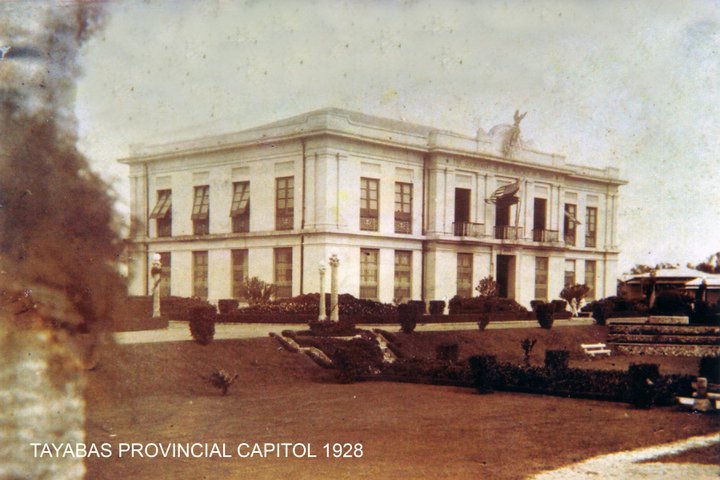Province of Quezon: Brief History of the Province
Brief History of the Province
Quezon is the largest province in the CALABARZON region and is primarily agricultural in nature. It is the 8th largest province in the country, with a total land area of 8,706.60 Sq. Km.
It was originally called Kaliraya/Kalilayan, after its capital town (now Unisan) upon its creation 1591. However, around the middle of the 18th century, the capital was transferred to the town of Tayabas which then also changed the name of the province to Tayabas. The territory which now constitutes the province was at one time under the jurisdiction of various provinces. The southern and central portions were under the province of Bonbon, sometimes called Balayan, in 1585. The northern portion was divided between Laguna and Nueva Ecija.
History records this province was explored by Juan de Salcedo in 1571 and 1572 during his expedition from Laguna to Ambos Camarines. He also visited the twns of Baler, Casiguran, and Infanta. Like many other provinces, Tayabas suffered from Moro depredations. In 1798, a fleet of some 25 or more boats harassed the towns of Casiguran, Palanan, and Baler where 450 captives were taken. The towns along the southern coasts of Bondoc Peninsula were also at their mercy. These depredations continued almost to the end of the Spanish rule.
Another important event in the annals of the province is the famous Revolt of the Cofradia in 1841. This revolt was led by Apolinario de la Cruz, a native of Lucban, and once a lay brother in the San Juan de Dios Hospital. The rebellion spread to a few towns in the neighboring provinces of Laguna and Batangas. Apolinario de la Cruz was called by his followers as “The King of the Tagalogs”. Tayabas was the first province to join the revolution. On August 5, 1898, General Miguel Malvar took possession of Tayabas in the name of the Revolutionary Government. On March 12, 1901, a civil government was organized with Lucena as its capital. The following year, the districts of Principe and Infanta, including Polillo, formerly a dependency of Laguna were annexed to Tayabas.
With the advent of the Japanese occupation, the Japanese Imperial Army first set foot along the shores of Atimonan on Dec 23, 1841. This province was not spared, and the people suffered under the brutalities and atrocities of the Japanese soldiers for 4 years. Finally, on April 4, 1945, the American forces marched triumphantly into Lucena, which marked the formal liberation of Tayabas, now Quezon Province.
Tayabas province was changed to “Quezon Province” by virtue of Republic Act No. 14 as signed by the late President Manuel Roxas on September 7, 1945, as a gesture of homage and respect to one of the distinguished sons of this province, the late President Manuel Luis Quezon, the first president of the Philippine Commonwealth.
QUEZON PROVINCIAL CAPITOL RESTORATION PROJECT
Joel Vivero Rico, FPIA
Restoration ConsultantHistory
The Province of Quezon, formerly known as Tayabas, is situated in Southern Luzon. Prior to its establishment in 1578 by two Spanish Franciscan friars named Fr. Juan de Plasencia and Fr. Diego Oropesa, what is now known as the City of Tayabas was a Muslim village ruled by a local chieftain and elders. From 1749 to 1901, it served as the capitol of the province with the same name.
During the Spanish Period, Tayabas was redesigned in accordance to the European town planning principle – with the church at the heart of the town, and in front of it, an open plaza surrounded by the municipio and mansions of rich locals. It was during this time that Tayabas became a busy fishing and farming town centre.
The first municipal building of Tayabas was designed by the Obras Publicas (Public Works) following a bahay na bato concept, with Adobe walls on the first floor and wooden bandejas (exterior wooden panels) on the second floor, topped by a brick roof with wooden trusses. However, it was constantly repaired and restored due to the presence of monsoon rains and strong typhoons.
As chronicled in the history of the Philippines, Moros have resisted the rule of the Spaniards for many years. Part of this conflict involved attacks of Moro pirates, which did not spare Tayabas. To protect the town’s inhabitants, the Spanish built stone fortresses and watchtowers which secured fish ports, agricultural areas, as well as commercial and trading centres.
One such area is La Cota (the Fort) – an arabales (outskirts) of Tayabas with heavily fortified walls and cannons called Fuerte de San San Miguel. It became integral part to the overall defence of the province which included the watchtower of Pagbilao and Fort San Diego in Gumaca. Later on, La Cota was renamed as Lucena and separated from the town of Tayabas in 1882 to become an independent municipality. Several years later, on March 12, 1901, the capital was moved from Tayabas to Lucena because of the latter’s strategic location and accessibility to the sea.
In 1906, during the American Period, a large provincial capitol complex was developed in Lucena, it was designed to ultimately become the centre of the growing province. It featured an infirmary, a jail, a courthouse, a constabulary outpost, a school, sports facilities, and a large open space assigned as a public park. All of this was conveniently located in close proximity to the Philippine National Railroad station in the area, which connected Tayabas to the country’s capital in Manila.
The first provincial capitol building was erected under J.W. Beardsally, the Director of Public Works during the incumbency of Tayabas Governor Domingo Lopez. The Manila Saw Mill served as the project contractor, with the famous American architect William Parsons as Consulting Architect. W.S. Haldeman acted as the Maestro de Obra (master builder), Hugh Redmond served as the project supervisor, while R.N. Rhamey was the project inspector.
The building was a two-storey structure with an American colonial type of architecture, highlighted with a sculpture of an American eagle on its façade – a symbolic reminder of the American presence in the province. It featured an excellent tropical design concept with its cross ventilation from wooden capiz windows with ventanillas, and its high ceilings. The primary materials used for its construction were concrete, adobe stones, and wood.
However, because of the need for new offices, the increasing population, as well as the perennial damages caused by typhoons and earthquakes, President Manuel Quezon – a proud native of the province – deemed it necessary to enlarge the existing capitol building of his beloved Tayabas.
New Tayabas Capitol
Juan Marcos Arellano, one of the most significant Filipino architects of the 20th century, and the head of the Architecture Division of the Bureau of Public Works at the time, submitted the construction of a new capitol for Tayabas in 1933. However, considering the original structure which was designed by his mentor, American architect William Parson, Arellano decided to expand and enlarged the new capitol leaving parts of the Parson’s design intact.
Arellano’s concept was to “envelop” the entirety of the old capitol while building new spaces. His approach respected the earlier architecture without compromising his signature style, showing his creativity and flexibility, as well as his reverence for heritage and history.
The new provincial capitol merged neoclassic formalities, balance and symmetry, with the then-popular art deco motif in terms of architectural finishing and details. His friend, the famous Italian artist Francesco Monti, created the structure’s accent statues which represented the livelihoods of Tayabas natives.
Civil Engineer Sotero Baluyot, and Gotauco and Company served the as the expansion project’s contractors. And after two years of construction under District Engineer Sergio Bayan, with the financial supervision of District Treasurer Andres Agcaoli, the new Tayabas provincial Capitol was formally inaugurated in 1935. Present during the event were Tayabas Governor, Hon. Maximo Rodriguez, and Provincial Board Members Leon Guinto, Pedro Insua, Leon Malubay, Marciano Principe and Jose Nieva.
After its opening in 1935, the building became an admired government structure in the Philippines. The cutting-edge design, the advance construction methods, and materials used became the benchmark of other government structures. The unity between the elegant American neoclassic design and the avant-garde and expressive Art Deco motifs gave the capitol its distinct personality – which became a source of pride, as well as a symbol of success for the Province of Tayabas.
However, with the onset of World War II in 1945, the building was inevitably damaged. But thanks to the American War Reparation funding, it was rebuilt to its former glory in 1950. It was also around this time that the Province of Tayabas was renamed the Province of Quezon in honor of its distinguished native,President Manuel Quezon – thus formally renaming the building to the Quezon Provincial Capitol.
Post-War Quezon
As the years passed, the Quezon Capitol Building saw remodeling of its interiors because of the need for more offices and the growing number of provincial government employees. The construction of additional mezzanines inside existing offices, repartition of walls, as well as the reallocation of old rooms, made the capitol building incur unnecessary damages such as electrical, plumbing, and even structural concerns. Several officials of Quezon have already attempted for its restoration and rehabilitation in the past. However, their efforts did not materialize.
The Capitol of Today
The Quezon Capitol Building is more than just a piece of architecture. Aside from its intrinsic value, it is a testament to this province’s proud heritage and rich history. In line with this fact, the Provincial Government of Quezon, under the leadership of Governor David Suarez, with the support of Vice Governor Samuel Nantes and the Quezon Provincial Board Council, decided to pursue its restoration once more. But this time, they are determined to see it through.
Modern functionality and historical accuracy will be the centerpiece of this project’s restoration concept. The involved parties envision a capitol building echoing the atmosphere of Quezon’s pre-war era, without having to sacrifice convenience and the use of technology. It will feature a museum housing the province’s memorabilia, and a Governor’s Hall which will showcase the significant contributions of all the governors of Quezon, and their shared vision for the success and development of their province even beyond the 21st century.
Among all the provincial capitol structures in the country, the Quezon Provincial Capitol holds some of the most distinct architectural significance due to its collaboration of style, details, and architectural history. It is only right to protect it and restore it to its former glory. And now, through the guidance of the National Historical Commission of the Philippines (NHCP), the Provincial Engineering Office, and other attached agencies of the provincial government including the Provincial General Services Office, the Provincial Library, the Provincial Public Information Office, and the Provincial Tourism Office, are now working together to make the restoration of the Quezon Provincial Capitol a reality.
—-
Source: https://www.quezon.gov.ph/general-information/history
5 Likes1 Reply
Thanks

























